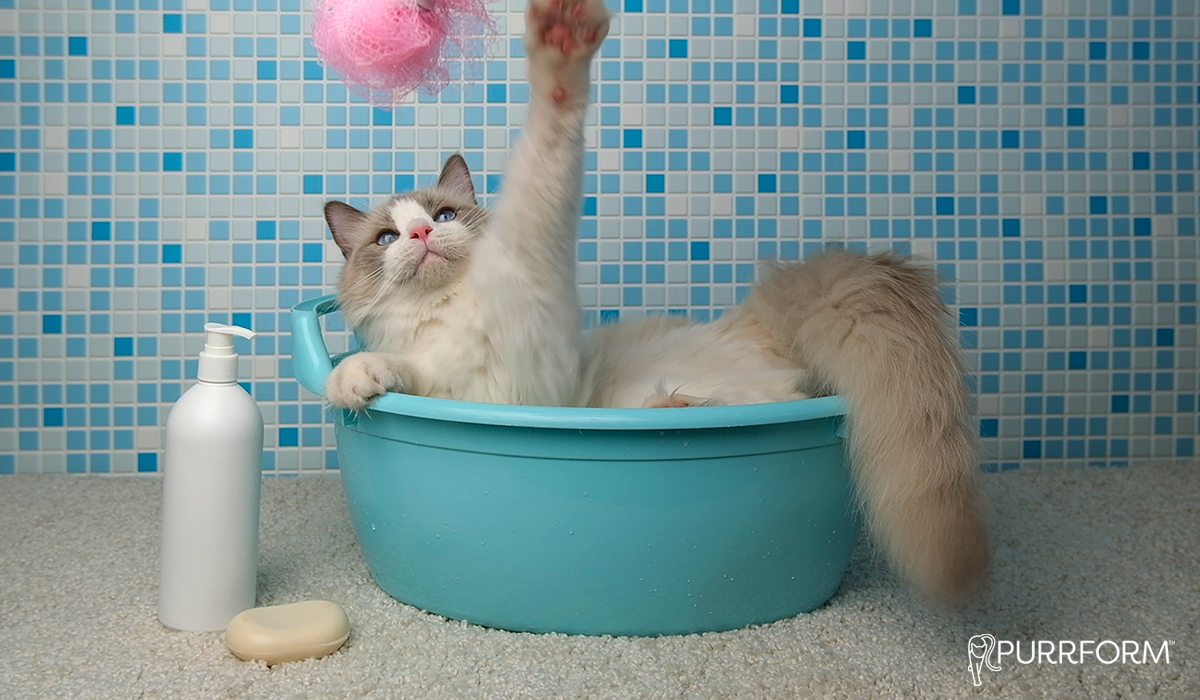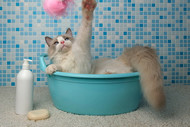Bathing your cat
24th Oct 2024

This month, we look at the topic of bathing cats – do cats need to be bathed, what actions can we take to avoid bathing them and what can we do to get them more used to being bathed, if we decide this is required?
Do Cats need to be bathed?
In general, the answer is no, cats do not need to be bathed. Most cats are very good at keeping themselves clean and well groomed. Also, bathing can strip the coat of essential oils which are needed to promote skin health and add a layer of waterproofing. However, there are some exceptions to this rule. Here are a few examples;
- If you cat has rolled in something unpleasant or toxic.
- If your cat is overweight and unable to properly groom themselves.
- if your cat is lethargic and doesn’t keep up with regular grooming.
- If you cat has a wound or a medical condition which requires medicated baths.
- If your cat has a long coat and struggles to keep themselves groomed and matt free.
Alternatives to bathing your cat.
Sometimes we can avoid giving our cats baths by using the following solutions;
- If your cat is dusty or muddy, first try brushing or combing out the dirt before resorting to giving them a bath.
- If your cat has a small sticky patch, you could try using either specialist pet safe wipes, or a damp cloth / flannel & a pet safe dry shampoo.
- Regular brushing is a great way of avoiding having to bath your cat and keep on top of any knots that may occur before they become matted.
How to get your cats used to baths.
If you do need to bath your cat, there are some points to remember. Most cats do not have a natural inclination towards water, let alone sitting in a tub filled of it, so it’s very important to introduce your cat to the bathing process slowly, so as not to stress them too much which can also cause them to lash out in panic.
For most cats, getting them used to baths is a very slow and gradually process, as instinctively cats will stay away from water.
First start by dripping small amounts of water on your cats back and legs to get them used to the feel on their coat, do this for a few minutes a day and slowly build up to a bath.
When first giving your cat a bath, try bathing them in a kitchen sink or small container, so as not to overwhelm them and remember if they want to leave, let them, as you don’t want them to feel overwhelmed and anxious about the experience.
Talk to your cat in a calm, gentle voice and try using treats and maybe a favourite toy to encourage them to stay in the water, remember you want your cat to see this as a positive experience.
Before shampooing your cat rub your hands round them as if you were shampooing them to get them used to the feeling. Next build up to rinsing them, without actually adding shampoo, so you can check they will allow you to do so, and you won’t end up with a cat covered in shampoo, who refuses to let you rinse it off!
Once your cat is comfortable with this you should then be able to add shampoo. Start with a very small amount at first and make sure you rinse thoroughly to avoid skin irritation, being very careful to avoid soapy water from running into their eyes, nose and mouth.
Never use a shampoo for humans, as these can be damaging to their fur or skin and may even be toxic to them. Only ever use a special shampoo designed specifically for cats
Once your cat has been fully rinsed, get them out of the bath and wrap them in a warm towel and gently pat them dry. Do not use a hairdryer, as most cats find this sound quite frightening. Make sure you dry your cat well and keep them in a warm room afterwards, as wet cats can get cold very quickly.
Hopefully this guide will help you decide whether it is really necessary to bath your cat and if you feel it is required, you are able to bath them without you, or your cat, getting too stressed, to avoid any unnecessary scratches and any adverse consequences.
